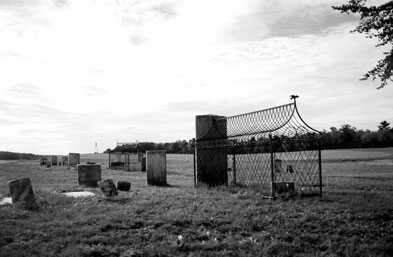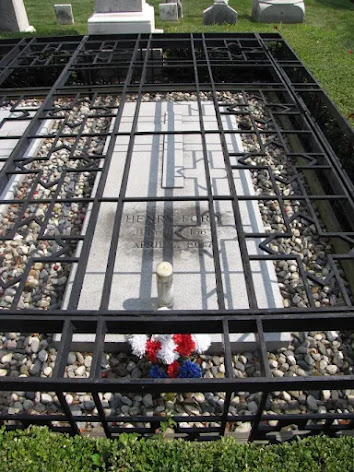Located in Columbia County Pa, it's are some of the only remaining examples of mortsafes, built to keep grave robbers out, in the United States. [Another is over the grave of Henry & Clara Ford] As the practice of bodysnatching waned, most cages were reused or repurposed. These, at the Old Mount Zion Cemetery in Catawissa, still stand.
It is not known why these graves have the cages, but there are a number of theories. The least likely is that the women were vampires. The Thomas family, from Scotland, were iron masters, and it's much more likely that they were adhering to an old Scottish tradition when placing the cages. From a practical standpoints, they may also have been to prevent animals, or thieves, from digging up the graves. This was a time when it was common for doctors to pay thieves to dig up bodies for them to use for educational purposes.
"It is now more than sixty years since the Anatomy Act was passed, and there are probably few who remember, except as a tradition, the horrors of the preceding time, when the medical schools were supplied with subjects for dissection chiefly by men who stole corpses from the grave. These men were called body-snatchers, or, in a slang phrase, "resurrection men."
Frequently referred to as "Vampire Cages", Mortsafes were structures placed over a burial site to prevent the body being stolen for use by anatomy instructors or medical students. There was no legal source of cadavers in the 18th and 19th centuries. Thieves were frequently paid to supply them.
"Respect for the dead made the idea of this violation of the grave horrible to the survivors, and various means were devised to secure that the bodies of the beloved dead should remain undisturbed. The iron coffin, instead of the usual wooden one, was so intended. A heavy iron cage, called a "mortsafe," was another. Mortsafes were of various kinds. Some formed almost a house of iron bars, with a locked gate to it. Others lay flat on the grave, and consisted sometimes entirely of iron, and sometimes of a border of strong masonry with iron bars on the top."
In 1886, a West Chester Newspaper reported that William Miller had purchased an acre of land in Kennett Square "on which he will erect extensive shops.. principally for the manufacture of iron grave cases"
In 2007, historian Ted Fenstermacher interviewed Amos Fetterman. In the ensuing article Fenstermacher wrote:
“Amos Fetterman who lives but a short distance from the
graves, said he understands placing such iron structures over graves was a
custom brought over from England. The belief is that, in earlier days, when
bodies were not embalmed and were buried in ordinary wooden coffins the iron
structures were to keep dogs, wolves or other animals from digging down to the
bodies.
Fetterman recalls that when his father bought the Fetterman farm in 1914, the cages were still in good condition, and each had a hinged door on the end.”
In a 2005 tour, local historian Wayne Petro said he believed the wrought iron webs were ornamental, not to prevent wolves & grave robbers.
There were originally three hooded graves at the cemetery in Catawissa, but today only two remain. The third cage was reportedly removed in the 1930s, due to its state of disrepair. The cages that are there now are not the originals. The originals deteriorated, and in the 1990s they were rebuilt.
On November 13 1999, the cages were rededicated. After being restored, the wrought iron cages were returned to the grounds by horse and wagon.
The "salvaged pieces were incorporated into one cage, while the other was completely rebuilt using photos and the old rusted remains as guides" - Cale Beaver, who helped with the restoration.
In 2009, the Old Mount Zion Methodist Church Cemetery received a new sign, "Hooded Grave Cemetery".
=================
The Thomas Family
The graves covered belong to three women: Rebecca (Thomas) Clayton and Sarah Ann (Thomas) Boone, who were cousins. Asenath (Campbell) Thomas was the wife of John Thomas, bother of Sarah.
|
SARAH ANN, CONSORT OF RANSLOE BOONE DAUGHTER OF LLOYD & FRANCES THOMAS ENTERED INTO REST JUNE 18, 1852 AGED 22 YEARS 6 M. 9 D. It's believed that the women died in childbirth, or from complications related to childbirth. Sarah's daughter had been born on June 2 1852.
|
Asenath B. Consort of John F. Thomas. Daughter of Joseph B. & Anna G. Campbell Entered Into Rest June 26th 1852 Aged 20y
|
|
Born June 26 1852, she died Nov 5th of that same year.
|
Rebecca S. Thomas Born 6/14/1826 Daughter of Abel & Ann Thomas Married Nelson Clayton Died May 12 1852
|
At the bottom of this post are the records for the cemetery.
Interestingly, Aseneth is not on the list, which was made by the W.P.A in 1936. It is almost certainly an oversight. Sarah [Thomas] Boone, Ann Thomas, Abel Thomas, Rebecca [Thomas] Clayton, Elizabeth Thomas all appear in the records. John, Aseneth's husband, is buried in Illinois.
The tombstones for Asenath & Sarah Ann are a nearly identical design.
=========================
Several members of the Thomas family were ironmasters, and they all were of Scottish descent. Mortsafes were once very popular in Scotland. It's likely that the Thomas family erected them purely as decoration, or out of tradition from their homeland, and not out of any real fear of the bodies being stolen.
It's accepted that there were grave robbers here in the Susquehanna Valley, as we did have doctors. It was not uncommon for doctors to obtain a cadaver to practice a surgery on, before performing it on his living patient. It appears that Dr McKelvy, a surgeon in Bloomsburg, for one, worked with illegally obtained cadavers. Sarah Ann Thomas married Ransloe Boone, a cousin of James Boyd McKelvy.
When the Lutheran and Reformed Cemetery in Bloomsburg was moved to Espy in 1925, more than 100 bodies were missing.
At a an October 2024 program of the History Buffs in Sonestown Pa, the speaker noted the similarity between the graves ironwork, and this decoration outside of Cerridwen's Garden on 5th street in Bloomsburg.
==================
READ MORE
==================
In 2013, Dianne Salerni published a young adult novel, "The Caged Graves", inspired by the graves at Catawissa.
William Hummel, convicted of brutally murdering his wife and her three children, went to great lengths to assure that after his hanging his body would not be "given to the doctors",
James Boyd McKelvy graduated from Pennsylvania Medical College and returned to Columbia County to establish his practice. In 1914, workmen digging in the alley next to McKelvy's home at the corner of Main street and Jefferson in Bloomsburg, discovered human bones buried there. The bones found were dismissed as "left over from some demonstration."
Sarah Ann married Ransloe Boone, a cousin of James Boyd McKelvy.
In the 1850s, the Lutheran and Reformed congregations split and built their own church buildings. The original building they shared was raised, but the congregations continued to use the burial grounds. In 1925, all of the bodies at that Lutheran And Reformed Cemetery in Bloomsburg, located on First Street at Center, were to be moved to Espy. A new high school was to be constructed on the location. The contract to remove the bodies was carried out under the supervision of Dr. S. Arment of the PA Department of Health. It was estimated that approximately 500 had been buried on the grounds, with more than one body in some of the graves. Only 369 bodes were officially removed. The Morning Press reported that Dr Arment was confident more bodies had been buried than were found, but no traces of them remained.
The cages were erected over the graves of three women who died in a 6 week period in
The wrought iron cages are 7 feet long, 3 feet wide, and 3 feet tall.
Henry Ford's Mortsafe
==================
[Mt Zion]
West Of Catawissa
=====================
=================
Read Charles D. Rodenbough's account of his visit to Pennsylvania, and his genealogical connection to the caged graves.
In his account, he includes:
"At least two of the women died in association with childbirth but that was a common killer at the time. One specific event occurred in February 1852 shortly before the deaths. In Cleveland some 150 miles away, the body parts of a young woman recently buried, turned up in a cesspool near a medical college. A committee of the father’s friends were allowed to search the school and found a female hand which the father later identified as belonging to his daughter. The news quickly spread to a mob outside the school which rioted, destroying furniture, chemical equipment, museum collection, and anatomical models and then set fire to the building.
Many other incidents, mostly less dynamic, centering on the fanatics of Resurrectionists, exacerbated the emotions in America. A rural location like Catawissa was not necessarily immune. The Reading Railroad was just a few miles from Old Mt Zion Cemetery and there was a regular run of trains from Pottsville to Philadelphia connecting the availability of even these rural cadavers to the demand.³
More logically, the demand for cadavers, may have been nearer by and may explain better the reason that the Boone/Thomas families were moved to have these cages constructed. Remember also the family connections with the iron industry around Catawissa.⁴ In 1833, William Boone married his second wife, Rebecca Purcill and by her a one son whom they named William McKelvy Boone. William, born in 1834, was a half-brother of Ransloe Boone and had been named for William McKelvy, a local friend. This friend had a son, James Boyd McKelvy born in 1824, who graduated in 1848 from the University of Pennsylvania in Philadelphia and established himself as a surgeon in Bloomsburg. It was McKelvy who might have foreknowledge of a plan to snatch bodies from Mt. Zion and had warned his close family friend. In precaution, the cages might have been manufactured to a local design and placed on the graves. "
Ransloe Boone
From the Find A Grave Entry For Ransloe Boone:
Ransloe Boone was the grandfather of Admiral Joel Boone. He 1896 when he and his wife were driving a single horse hitched to a carriage from Pottsville to St. Clair. At a point on the road where there was a steep unguarded embankment, the horse became frightened and unmanageable and plunged down the embankment. Mr. Boone was killed instantly and his wife was seriously injured. Later the widow filed suit against Norwegian Township for failing to have a guard rail. A jury awarded her $2,000. The Township appealed all the way to the PA Supreme Court, the high court sustained the verdict.







.jpg)
















.jpg)






.jpg)






No comments:
Post a Comment
I'll read the comments and approve them to post as soon as I can! Thanks for stopping by!